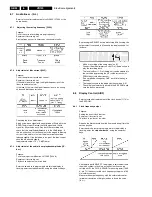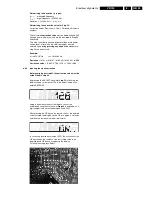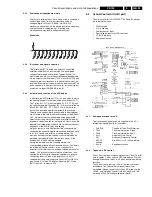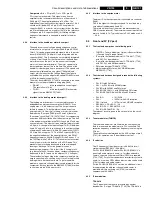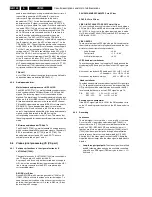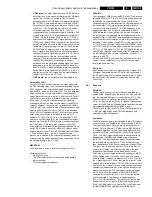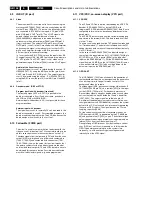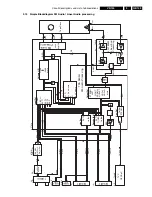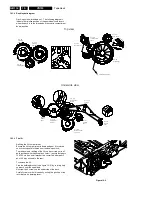
Circuit descriptions and List of abbreviations
GB 104
VR120
9.
Chroma PAL
This is first adjusted in the AGC stage to a constant level and
filtered in the FM processing (PB-EQ). The signal exits the IC
on pin 18 [7004], and passes via an E-follower [7010] with
drop (1.07MHz ). On pin 17, the FMPV signal is carried from
the head amplifier to the IC [7007] signal electronics.
From the FM playback signal the 627 kHz chroma signal is
filtered using the internal low pass (C_LPF). The ACC
amplifier amplifies and controls the chroma amplitude. In the
main converter (MAIN CONV), the chroma signal is mixed
with 5.06 MHz back to the original 4.43 MHz. The 5.06 MHz
are produced in playback from the free-running quartz
oscillator and from the (40+1/8) f
H
= 627 kHz frequency
derived from the 321fH-VCO. After the main converter the
chroma signal is freed as far as possible from crosstalk from
additional traces using a 2H comb filter (internal CCD
connections: pin 57 -> 54; pin 59 -> 52 and pin 51 -> 61). The
chroma signal is then filtered using a low pass (LPF),
checked by the colour killer, filtered once again by a band
pass, looped through pins 72 and 71 and then added to the
Y signal.
Chroma MESECAM
The signal path is virtually identical to the path for PAL.
The differences are:
•
No phase rotation.
•
The comb filter is not active.
Chroma SECAM L
During playback the FM signal is passed from the band on
pin 74 [7004] after the E-follower [7002] (FMPV) to pin 13
[7072], where the amplitude is adjusted in the AGC and
passed via the same band pass (1.1MHz BPF) as for
recording. The NF pre-emphasis for the recording is then
reversed using a cloche filter (external filter components on
pin 8; the same components as for recording). In the
subsequent stages the frequency of the signal is doubled,
filtered using a band pass (2.2MHz BPF) and doubled once
again. Then follows another band pass (4.3MHz BPF-B), and
then the limiter (LIM) already used for recording. The signal
is then suppressed again during the H-sync. period and
passed through a band pass filter (4.3MHz BPF-A; also used
for recording). Before the SECAM-chroma signal exits the IC
on pin 17 [7072], an Hf pre-emphasis is carried out once
more (anti-cloche; external filter components on pin 21; the
same components as for recording). After pin 17 there is a
drop at 2.4MHz which suppresses the 2
nd
harmonic of the
chroma from the band, a low pass filter which improves the
harmonics of the high frequency chroma and a transistor
[7073] which has an emitter connected to pin 72 (CSRP) on
the SE IC [7004].
NTSC
During the playback of NTSC signals, the original NTSC
chroma is converted into a PAL chroma signal. This requires
an internal switchover in the IC in the chroma part:
The internal CCD is switched over on a 1H comb filter to
reduce crosstalk.
The NAP switchover is activated and translates the 4.43MHz
NTSC chroma signal into a PAL signal.
Line and picture frequencies remain unchanged in
accordance with the NTSC standard.
The result is a 60Hz NTSC Y-signal with a 4.43MHz PAL C-
signal.
PAL M,N
As for chroma PAL (6.3.3).
9.6.4
General
SECAM:
Automatic cloche and anti-cloche comparison: During the
vertical blanking gap the external filter components (pin 21 or
pin 8) on the cloche or anti-cloche are used to create an
oscillator and to divide the resonance frequency produced,
and compared with a frequency derived from the 4.43MHz
oscillation (reference signal from the SE IC [7004]).
Depending on the deviation, more or less internal capacity is
connected in parallel to the external cloche and anti-cloche
filter components. This process is carried out during each
vertical blanking gap and thus also improves the temperature
stability.
Chroma selection for REC and PB pin 71 and 72 SE IC
[7004]:
Both the PB chroma and the REC chroma in PAL
(MESECAM, PAL M/N) and also in SECAM are passed into
the SE IC [7004] via pin 71 [7004]. In all PAL and MESECAM
modes the DC voltage is on the base of the output emitter
follower pin 72 [7004] 3.2V and the both bases of transistors
[7077] and [7073] of the SECAM chroma signals are at 0V -
> the PAL/MESECAM chroma signal is added to the FM-Y
signal or to the PB-Y signal, according to REC or PB. In
SECAM PB mode only the transistor [7073] has 2.5V DC
voltage on the base. In SECAM REC mode only the
transistor [7075] has 2.5V DC voltage on the base.
9.7
Audio linear (AL part)
9.7.1
Audio I/O for the 1-scart version
The input is selected via the IIC bus control in the IC signal
electronics [7004-A]. Either signal AIN1 (pin 76) or AFV (pin
80) is selected. The output signal AMLP (pin 96) is passed to
scart 1 and to the HF modulator.
9.7.2
Audio I/O for the 2-scart version
The input is selected via the IIC bus control in the IC signal
electronics [7004-A]. Either signal AIN1 (pin 76), AINF_AIN2
(pin 78) or AFV (pin 80) is selected. The output signal AMLP
(pin 96) is always passed to the HF modulator.
9.7.3
Audio linear recording
The signal inputs for recording or loop-through are pins 76,78
and 80 on the linear audio part of the IC LA71595 [7004-A].
During record and loop-through, the selected signal passes
through the linear amplifier and then a mute stage and exits
the IC on pin 96. This is the output which leads to the I/O part
or the stereo units back to the AF part. The attenuation chain
on pin 96 sets the required level for the ALC (Automatic Level
Control) detector and the level for the recording amplifier.
The time constant for the ALC detector is specified using
R3605 and C2602 on pin 77. R3634, R3640, C2626 and
C2627 create the frequency response for the recording
amplifier. The output for the recording amplifier is pin 7. The
recording current is then added to the bias current via resistor
R3642 and flows via the audio head to pin 4 where an
electronic switch is closed in the IC.
In long play mode the frequency characteristic is modified to
the RC network R3635, R3641, C2630, C2631 for the
recording amplifier.
The coil L5600 and the transistor T7608 create the erasing
oscillator for the main eraser head and audio track eraser
head, and generate the bias current for the audio head. The
bias current is set using potentiometer 3625.
To prevent spikes, the erasing oscillator is switched on
slowly. This is created using the switching stage T7603,
C2609, R3611 and R3613.
Summary of Contents for VR570
Page 12: ...Direction for use GB 12 VR120 3 3 Direction for use RT111 RT116 RT112 RT114 RT123 RT121 RT128 ...
Page 15: ...Direction for use GB 15 VR120 3 SAT VR870L VR870CC VR720 Set width 435 mm ...
Page 56: ...Service modes Repair tips GB 56 VR120 5 Engineer s remarks ...
Page 79: ...Circuit diagrams and PWB layouts Wiring diagram 79 VR120 7 7 16 Wiring Diagram Motherboard ...
Page 81: ...Circuit diagrams and PWB layouts Wiring diagram 81 VR120 7 Engineer s remarks ...
Page 82: ...82 VR120 7 Circuit diagrams and PWB layouts Wiring diagram Engineer s remarks ...
Page 83: ...Circuit diagrams and PWB layouts Wiring diagram 83 VR120 7 7 18 Mother board component side ...
Page 119: ...Tape deck GB 119 VR120 10 ...
Page 123: ...Tape deck GB 123 VR120 10 Engineer s remarks ...





